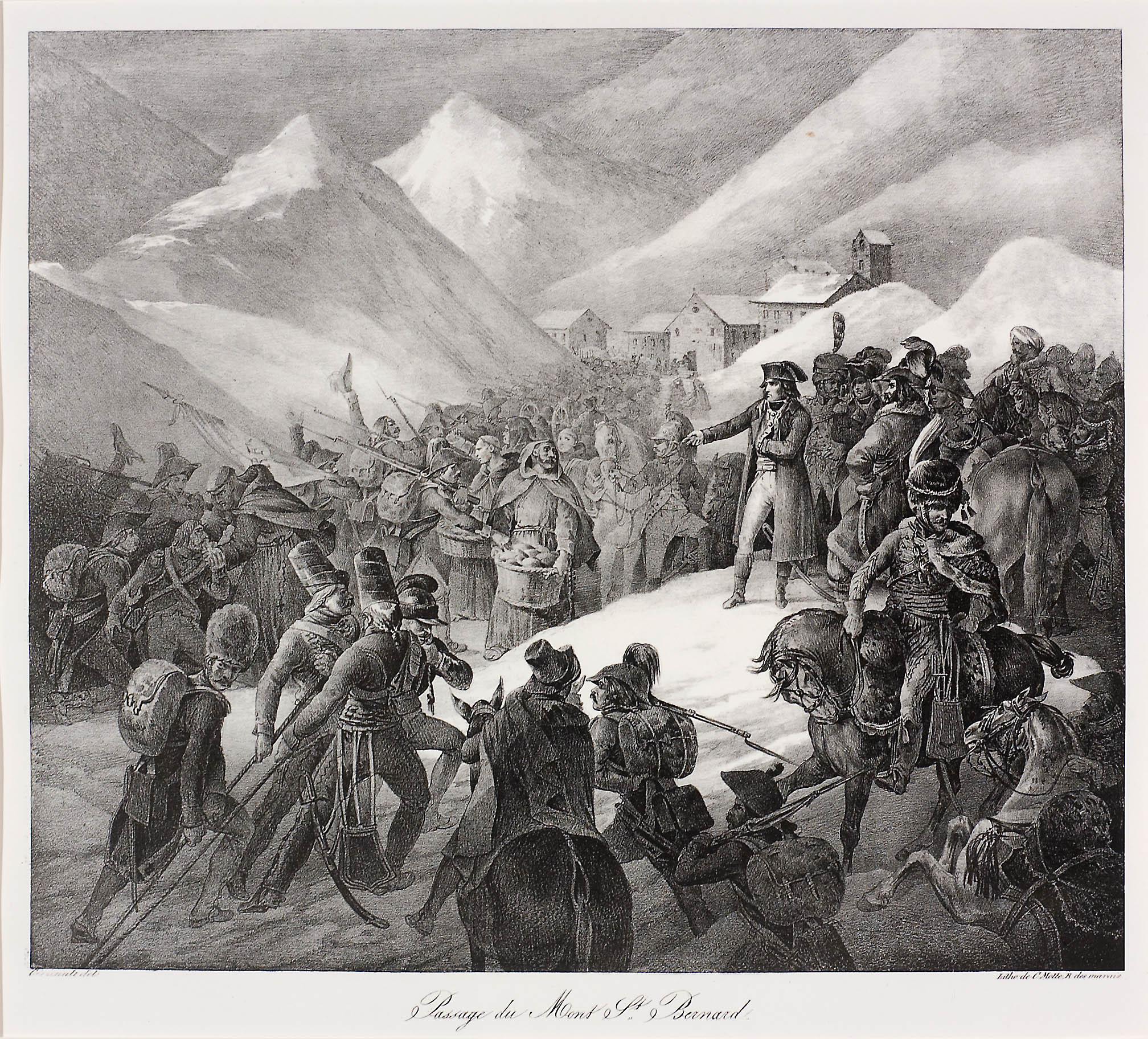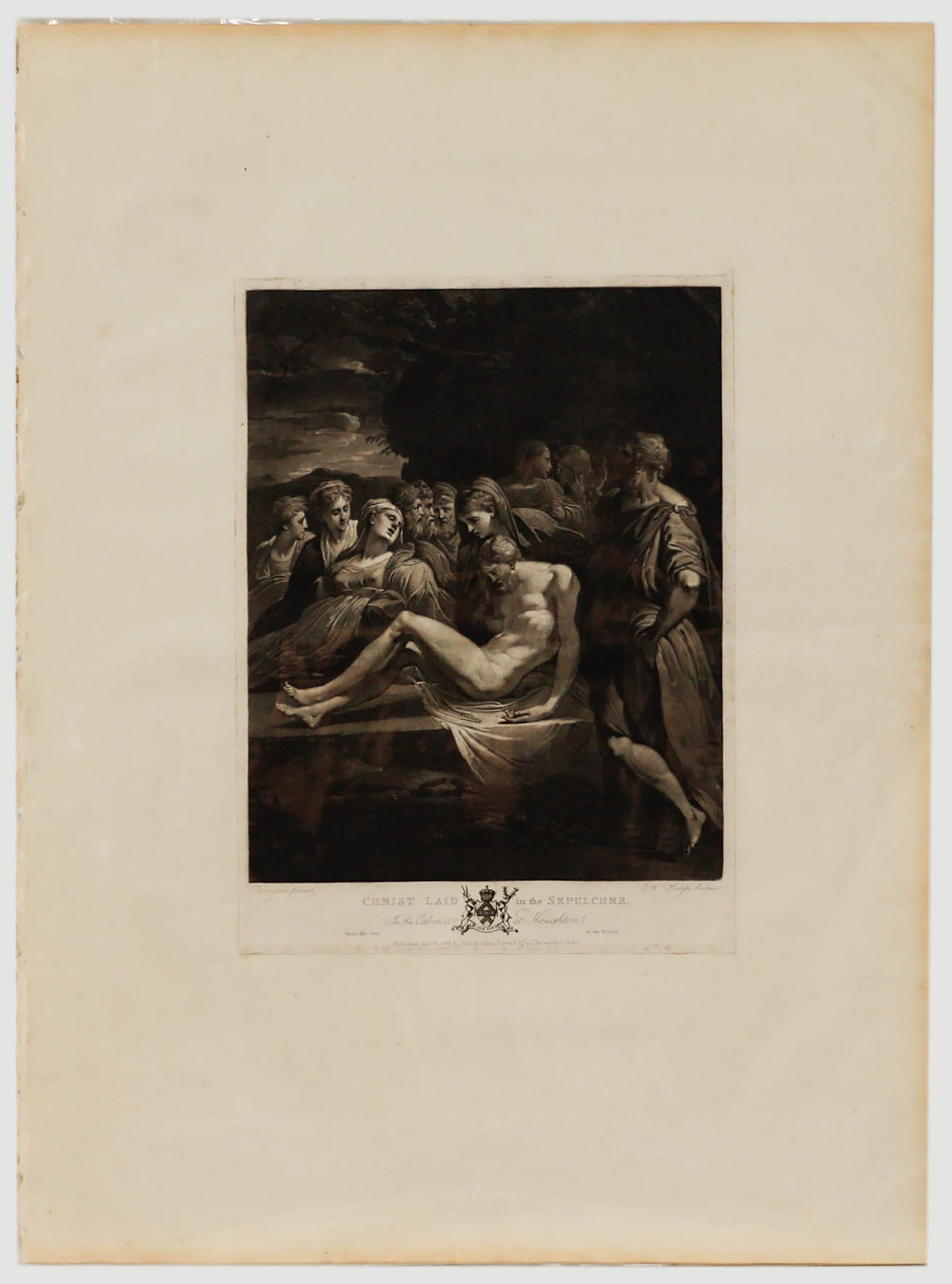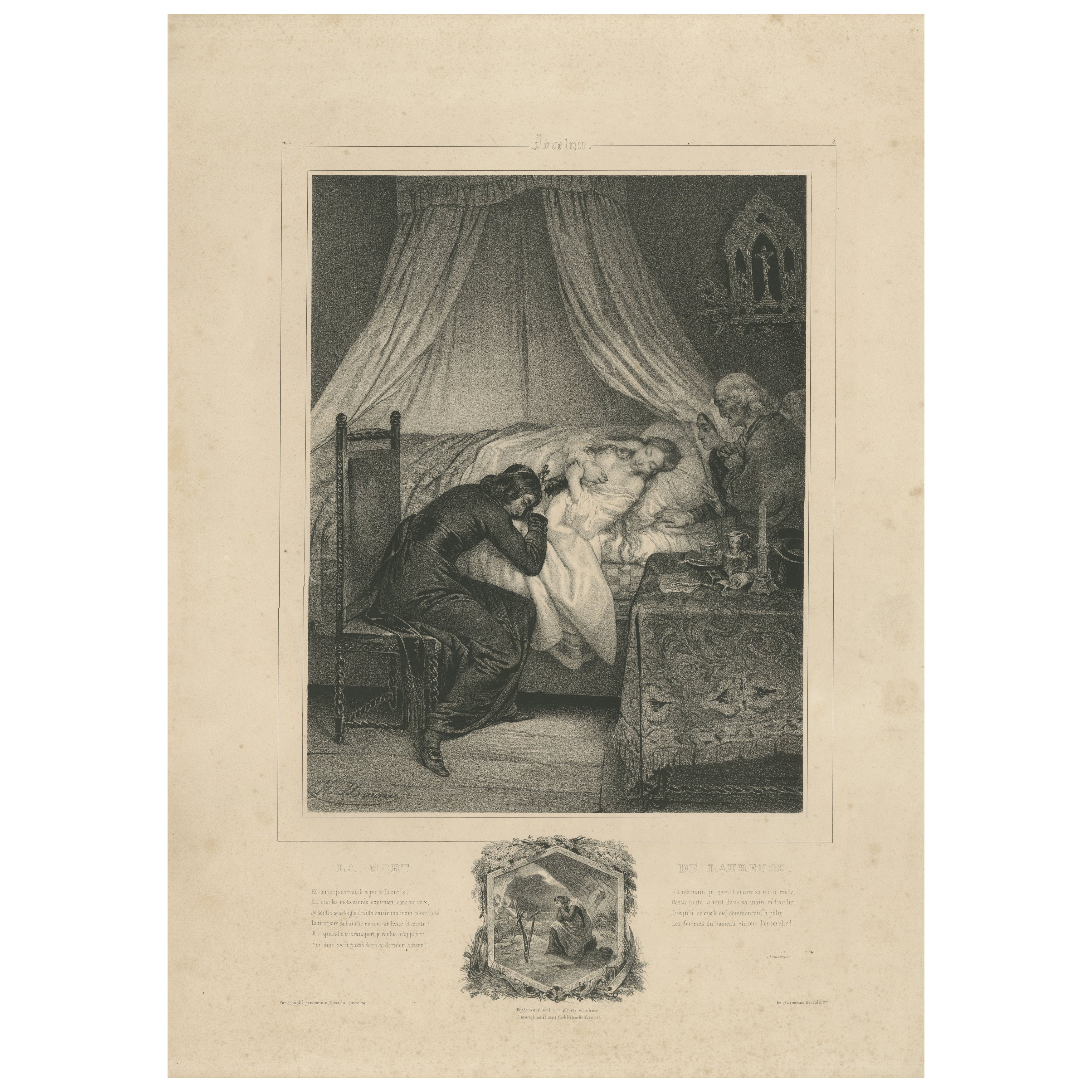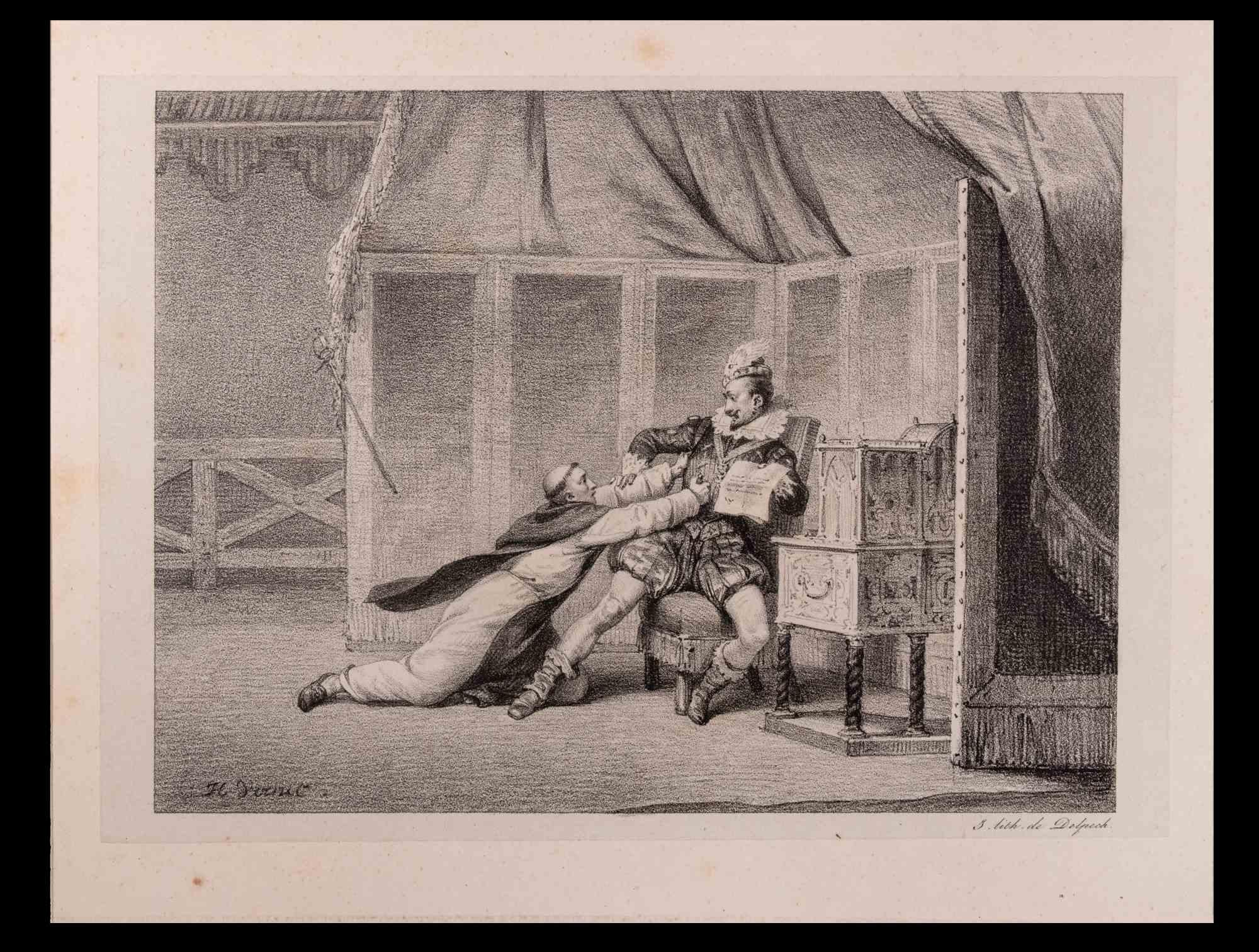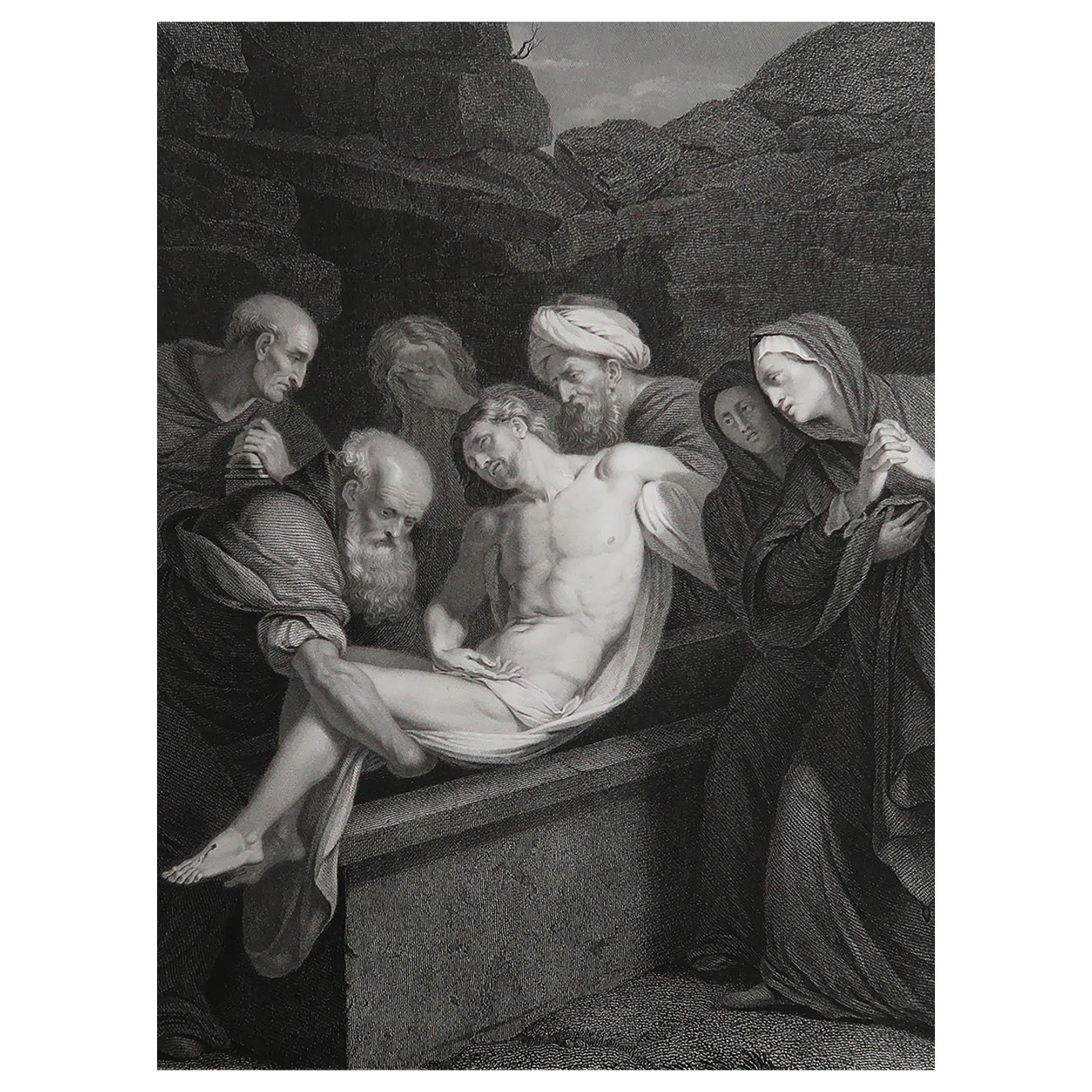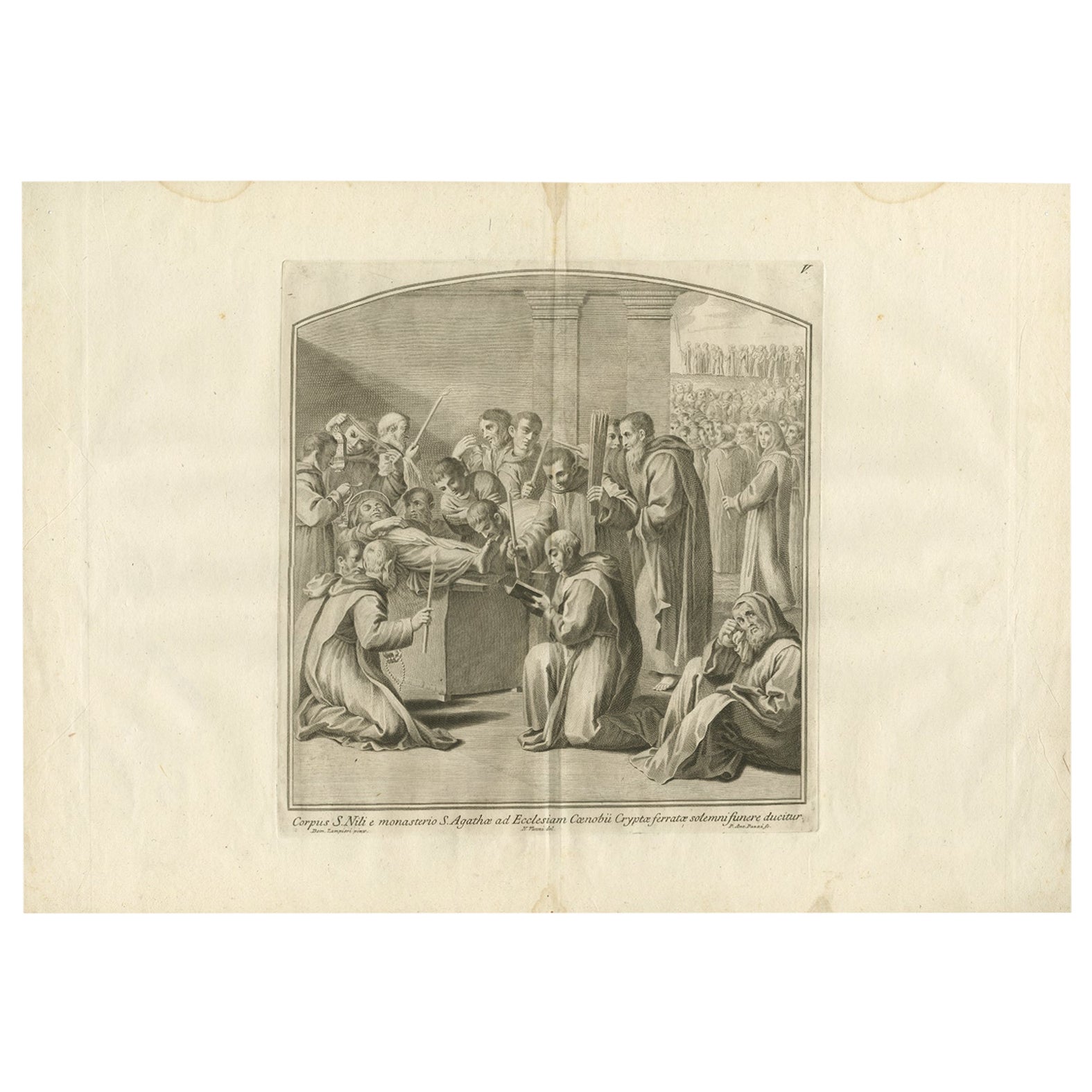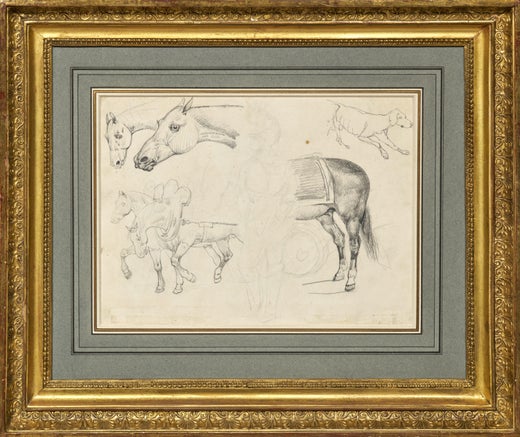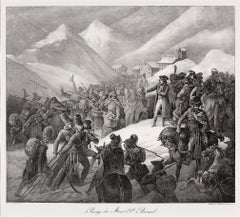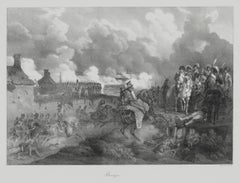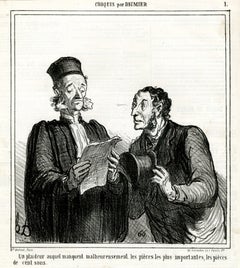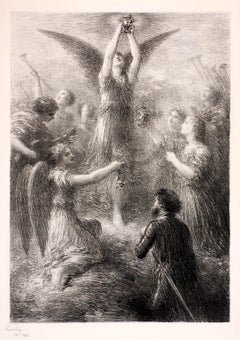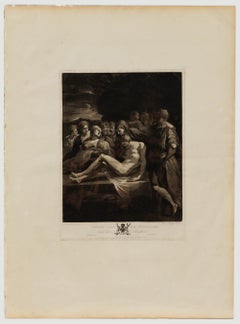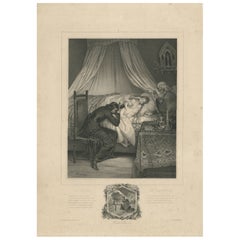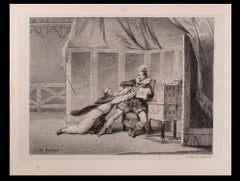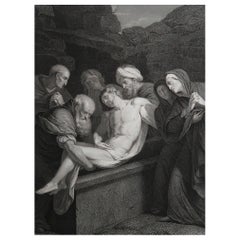Items Similar to Guillaume le Conquérant rapporté après sa mort à l'église de Boscherville
Want more images or videos?
Request additional images or videos from the seller
1 of 6
Jean Louis Andre Theodore GericaultGuillaume le Conquérant rapporté après sa mort à l'église de Boscherville1823
1823
$950
£717.40
€821.36
CA$1,341.65
A$1,464.76
CHF 767.91
MX$17,790.06
NOK 9,589.98
SEK 9,055.50
DKK 6,130.57
About the Item
Guillaume le Conquérant rapporté après sa mort à l'église de Boscherville (William the Conqueror brought back after his death to the church at Boscherville)
Lithograph, 1823
As published in 'Voyages pittoresques et romantiques dans l'ancienne France' (tome II: 'Normandie'). 1823
Reference: Delteil 78 ii/II
Conidition: very good
Image size: 6 x 7 1/8 inches
This image depicts the resurrection back to life of William the Conqueror.
Biography
Two biographies of Théodore Gericault have been published by the National Gallery of Art in the systematic catalogue of its collection. Both are given here.
By Suzanne Glover Lindsay, in European Sculpture of the Nineteenth Century, published 2000:
Gericault[1] is best known for his paintings, prints, and drawings. However, thanks to the plasticity of his forms in those media and a handful of reliefs and three-dimensional groups, he was repeatedly acclaimed for his great promise as a sculptor. That tantalizing prospect, however, was cut short by an early death at the age of thirty-two.
The artist was born in 1791 in Rouen to wealthy middle-class property owners, who moved to Paris when Gericault was about five years old. He was a poor student at the Lycée Impérial, indifferent to most subjects except drawing and classics. Gericault père opposed his son's decision to pursue artistic training. However, thanks to his uncle's subterfuge and his mother's bequest, in 1808 the boy secretly entered the studio of Carle Vernet (1758-1836), a painter of modern military and genre subjects that featured Gericault's lifelong mania, horses; he officially acknowledged Vernet as his master two years later. In February 1811, he entered the Ecole des Beaux-Arts, listed instead as a student of Pierre-Narcisse Guérin (1774-1833). Within a few months, Gericault quit attending his master's studio regularly, and turned to intensive study of the old masters on his own, copying paintings at the new Musée Napoléon (an early phase of the Louvre), until he was permanently expelled from the museum for assaulting a fellow student there in May 1812. He nonetheless competed regularly in the Ecole competitions.
Even during his student years, Gericault immersed himself as an artist and a citizen in the tumultuous events of the time, the twilight and aftermath of Napoleonic glory. Though he showed in only three Salons, his entries publicly stated a commitment to painting modern subjects. He made his debut in 1812 with the Equestrian Portrait of M. D*** (now known as Charging Chasseur [Musée du Louvre, Paris]), a dramatic monumental tribute to the Napoleonic epic. The painting won a gold medal but was not purchased by the state and triggered little critical discussion. Its later pendant in the Salon of 1814, the now-celebrated Wounded Cuirassier Leaving the Battle (Musée du Louvre, Paris), apparently fared no better with the critics and the new Bourbon government despite its subject, France's military losses under Napoleon. In the meantime, Gericault entered the political fray through the military. After avoiding the draft by "buying" a substitute three years before, in the spring of 1814 he joined the mounted Second Squadron of the Paris National Guard, then the First Company of Musketeers of the King that followed Louis XVIII into exile the following year, during the Hundred Days (March-July 1815), and was disbanded en route. Though accounts conflict, Gericault remained in hiding over those months, perhaps in Paris, despite Napoleon's law forbidding members of the royal household troops in or near the capital. With Louis' return to the throne in July, he resurfaced, was released from royal service that autumn, and became active in liberal artistic and military circles.
Gericault competed unsuccessfully for the Prix de Rome, but went at his own expense in the fall of 1816. His Roman works reveal his profound response to the antique, the Renaissance, and modern life. In early 1817, he executed studies for a monumental painting of the climactic feature of the Roman carnival, the riderless horse races on the Corso. The many preliminary works for the unfinished project reveal Gericault's conception of the subject as an epic, timeless frieze, a modern classic on canvas that invoked ancient sculpture, Renaissance frescoes, and baroque painting. He interrupted that stay to return to Paris by autumn, where he resumed a stormy liaison with his maternal aunt that remained a secret for decades. Their union yielded a child; she gave birth to their unacknowledged son, Georges-Hippolyte, in August 1818.
For the next two years, Gericault retreated into work for his third and final submission to the Salon, a huge canvas depicting a national scandal: the hardships of the crew of the French naval frigate Medusa, abandoned to a makeshift raft by its aristocratic officers who took the lifeboats. Shown simply as A Shipwreck Scene in the Salon of 1819, the painting won the artist a gold medal and a state commission for a religious work on the subject of the Sacred Heart of Jesus. Gericault was disheartened by the government's response (referring the commission to the younger Delacroix) and by the critical reaction, which he found myopic for debating the painting's possible political content instead of its artistic merits. In April 1820 he and an artist friend, Nicolas-Toussaint Charlet (1792-1845), took the painting, commonly called Raft of the Medusa (Musée du Louvre, Paris), on public tour through Britain, where it was moderately successful financially and critically. Gericault flourished artistically in Britain. His work exhibited at the Royal Academy received warm praise, and he found congenial colleagues and patrons as well as new sources of artistic inspiration. Gericault stayed in Britain for almost two years. During that fruitful period he executed watercolors, a series of horse-racing paintings (such as Epsom Downs Race, Musée du Louvre, Paris), and his important published suites in the new medium of lithography depicting other modern subjects from everyday life.
Gericault returned to Paris in December 1821 in declining health, which he aggravated by subsequent riding accidents. During those final years, the quantity of works he produced was small, but the power of the finished paintings--the ten portraits of the insane and the Lime Kiln--was compelling. Bedridden for most of 1823, he began studies for two projected modern history paintings, African Slave Trade and Opening of the Doors of the Inquisition. He died in January 1824. That autumn, after repeatedly failing while Gericault was alive, the director of the Louvre, the comte de Forbin, finally was authorized to buy Raft of the Medusa for the museum.
Gericault's accepted works in sculpture number about nine reliefs and full-in-the-round groups; seven of these have been identified as extant. Several exist in multiple versions and in various materials. Apparently, they were never publicly shown during the artist's lifetime, and were never considered fully completed. They range iconographically from classical mythological themes and equestrians to such modern subjects as wild animals and the Russian Czar Alexander. Stylistically, some display an almost Phidian austerity; others, a baroque robustness. Their relationship to Gericault's two-dimensional oeuvre is unclear. There is a general kinship of subjects and style, but no apparent direct counterparts in the various media for these works, unlike his study maquettes of animals or figures. The chronology of the sculpture is still debated. The works themselves are poorly documented. Only one has been given a date in the early literature; Charles Clément ascribed a bas-relief c. 1819. Some modern scholars place the sculpture at the beginning and end of Gericault's career as episodic exercises; others cluster them after 1816, as evidence of an increasingly fertile and tragically interrupted experimentation.
Gericault is consistently called a genius who died on the brink of full creative flower. His surviving works in every medium have always eluded categorization. Independent and undogmatic, he acted with both impetuous engagement and rigorous discipline, moved easily from classical to modern subjects, and integrated scrupulous preliminary studies with inspired invention, no matter the subject. He evolved a powerful coalition of solid draftsmanly structure, a light-catching, palpable three-dimensionality, and a painterly touch and palette. Gericault became one of the following generation's most haunting artistic paradigms, the ill-fated engaged genius. For many, his work signalled a brilliant path for the art of the future to negotiate between tradition and innovation.
[1] In contrast to traditional and very recent sources, this spelling follows Philippe Grunchec and his adherents in giving Gericault's name without an accented "e." The origin of the word is reportedly the river Ger in his native Normandy; family documents exclude the accent; and Gericault regularly signed his name without. However, apparently authentic signatures with an accent can be found on drawings and legal documents illustrated in Germain Bazin, Théodore Géricault. Etude Critique, documents et catalogue raisonné, 7 vols. and appendix, 1987-1997, 1:figs. 60-67. For arguments against the accent, see Philippe Grunchec, Tout l'oeuvre peint de Gericault, Paris, 1978: 83; Philippe Grunchec, Master Drawings by Gericault, Exh. cat. International Exhibitions Foundation, Washington, 1985: 11; and Lorenz Eitner's letter to Suzannah Fabing dated 12 September 1990 (in NGA curatorial files). Dr. Eitner's work on Gericault is included in his volume of the NGA Systemtic Catalogue devoted to early nineteenth-century French paintings, published 2000.
By Lorenz Eitner, in French Paintings of the Nineteenth Century. Part I: Before Impressionism, published 2000:
Théodore Gericault was born on 26 September 1791 in Rouen to parents of the property-owning middle class. The family moved to Paris in about 1796. On graduating from the Lycée Impérial in 1808, he declared his intention to become an artist. The death of his mother the same year brought him an annuity that assured his future independence. Against his father's wish, he apprenticed himself to Carle Vernet (1758-1836), the fashionable painter of equestrian subjects, who allowed him the freedom of his studio but seems not to have given him any formal training. Feeling the need for a more disciplined education, Gericault in 1810 moved to the studio of Pierre Guérin (1774-1833), a rigorous classicist and conscientious teacher, who made an effort to put him through the routines of the academic curriculum. Gericault proved to be a resistant pupil who kept up his attendance at Guérin's studio only for eleven months. Few traces remain of his student work. After taking amicable leave of Guérin, he continued his training as his own master, setting up his easel in the galleries of the Louvre, which were filled with the art loot of Napoleon's campaigns. Reacting against Guérin's classicism, he copied paintings by the dramatic colorists of the Renaissance and the baroque, particularly Titian, Rubens, Van Dyck, and Rembrandt, and intermittently continued these private studies of the masters until 1815, when the allies stripped the Louvre of Napoleon's booty.
At twenty-one, still a largely self-taught beginner, Gericault presented himself at the Salon of 1812, the last of Napoleon's reign, with his Charging Chasseur (Louvre), a dashing improvisation rapidly worked up into a picture of Salon format. Of provocative size, indebted to Antoine-Jean Gros (1771-1835) and to Gericault's recent impressions of Rubens, the Chasseur held its own among the Salon's grand performances and earned him a gold medal. After this precocious success, he resumed his self-training. Renouncing the magnitude and drama of the Chasseur for the time being, he occupied himself with small-scale studies from life, of horses observed in the stables of Versailles and brightly uniformed cavalrymen.
He witnessed the fall of the empire with seeming indifference and in the summer of 1814 enlisted in the Gray Musketeers, a royalist elite cavalry, more decorative than military. For the Salon that the Bourbon government hastily organized in the autumn of 1814, he reverted to heroic dimensions and the grand style with his Wounded Cuirassier Leaving the Field of Battle (Louvre), conceived as a pendant to the Chasseur, which was shown again on this occasion. The ponderous figure of the defeated soldier, modeled in intense, dark colors, marked his return to a style of calculated monumentality and heightened expressiveness.
On Napoleon's sudden return from Elba in March 1815, Gericault rode in the escort that covered the flight of Louis XVIII. During the Hundred Days he lay in hiding. His work to this point had belonged to the current of national modernity that was one of the two main tendencies in French art of the time. After Waterloo, he seems to have concluded that this vein, inextricably involved with Napoleon's reign, was exhausted. He made an abrupt change in his work, not only abandoning modern military subjects but also radically altering his style. With sudden determination, he turned to classical themes and, in an effort to teach himself the art of composing ideal subjects, inflicted on himself the kind of academic regimen that he had earlier refused to accept from Guérin. He rehearsed the rudiments of figure construction and composition, taking his motifs from the repertoire of classicist stock types that he had shunned in his student days. But instead of becoming a conforming classicist, he ruthlessly distorted the neoclassical idiom in the act of appropriating it. Romantic in its intensity, bearing the stamp of Michelangelo rather than David, this highly personal version of classicism lent itself--better than the fluent realism of his earlier work--to resonant dramatic statements.
In March 1816 he competed for the academic Rome Prize but failed the contest and decided to undertake the voyage on his own account. His Italian stay in 1816-1817 gave him profound impressions of paintings of heroic size that further stimulated his interest in problems of style and whetted his appetite for work on the wall-filling scale. The great enterprise of his Italian year was the project of a large Race of the Barberi Horses, suggested by an event of the Roman carnival that he had witnessed in February 1817. He began by recording the start of the race as he had seen it in the Piazza del Popolo, then gradually suppressed its picturesquely Italian features and transformed the modern scene into a timeless frieze of athletes struggling with horses.
On returning to France in the fall of 1817, he abandoned this project but continued briefly in its direction with studies for a Cattle Market (Fogg Art Museum, Cambridge, Massachusetts), conceived as a monumental battle between men and beasts. At the same time, he tried subjects of a more pointed contemporary significance, such as the murder of Fualdes, a sensational crime that he proposed to represent in the "antique" style. Meanwhile his renewed interest in modern subjects led him to take up lithography, a process recently imported to France, in which he attempted to treat scenes from the Napoleonic Wars in an elevated style, without falling into the conventions of classicism. The crowning result of these various efforts was the Raft of the Medusa (Louvre), completed in 1819, after an exhausting, yearlong struggle. The enormous canvas represents an episode of a recent shipwreck that had violently aroused French public opinion. The problem that Gericault set himself in composing his picture was to combine the immediacy of an eyewitness account with the permanence and stability of monumental composition. He thus sought to unite the two antithetical aspects of his art in a grand synthesis, reconciling historical realism with heroic generality: the modern shipwreck was made to echo Michelangelo's Last Judgment. At the Salon of 1819, the Raft of the Medusa, misinterpreted as an attack on the government, met with a mainly hostile reception.
Disappointed and exhausted, Gericault "renounced the grand manner to return to the stables" (Gericault to Pierre-Joseph Dedreux-Dorcy, in Charles Clément, Gericault, étude biographique et critique, avec le catalogue raisonné de l'oeuvre du maître, 3rd ed., Paris, 1879: 104). He went to England in 1820 to exhibit the Raft, and under English influence renewed acquaintance with that essentially anticlassical tradition of modern genre to which Carle Vernet had once introduced him. He sketched fashionable horsemen, farriers, beggars, and the caged animals in the zoological gardens in a manner that, if it lacked some of his customary force, had gained in subtlety of observation and freshness of color. A sporting picture of distinctly English inspiration, the Epsom Down Derby (Louvre), remained the only major painting of his year in Britain. When he returned to Paris in the winter of 1821, his health had begun to fail. Repeated riding accidents, aggravating a tubercular condition, brought on a painful and ultimately fatal illness. As death approached, his work regained much of its former compact strength while retaining its newly won refinement of color. In the industrial landscape of the Lime Kiln and in the series Portraits of the Insane, painted in 1822-1823, he achieved a style that was both realistic and in the highest degree expressive. In the final stages of his illness, he was overcome again by his old ambition to give epic grandeur to a scene from modern life and, though helplessly bedridden, projected immense compositions of such controversial themes as the African Slave Trade and the Opening of the Doors of the Spanish Inquisition. His death on 26 January 1824, at thirty-two, cut short these last efforts.
Courtesy National Gallery of Art, Washington
- Creator:Jean Louis Andre Theodore Gericault (1791 - 1824, French)
- Creation Year:1823
- Dimensions:Height: 6 in (15.24 cm)Width: 7.13 in (18.12 cm)
- Medium:
- Movement & Style:
- Period:
- Condition:
- Gallery Location:Fairlawn, OH
- Reference Number:Seller: FA126801stDibs: LU14016535212
Jean Louis Andre Theodore Gericault
Théodore Géricault was born in Rouen in 1791 into a wealthy family from the Manche region. His father, a magistrate and wealthy landowner, ran a tobacco factory. The family moved to Paris around 1796, and in 1810 Théodore Géricault entered Carle Vernet's studio, where he met his son Horace. He then studied with Pierre-Narcisse Guérin before enrolling on February 5, 1811 at the École des Beaux-Arts in Paris, where he pursued a classical training based on copying the masters at the Louvre Museum. Géricault was expelled from the École des Beaux-Arts in 1812 for his misconduct; he then rented a back store on rue de la Michodière, where he painted one of his first masterpieces, a portrait of an officer of the imperial guard (the Lieutenant Dieudonné) charging while on horseback. This painting was exhibited at the 1812 Salon and won him the gold medal at the age of 21! Géricault became a sought-after painter, specializing in military subjects. Géricault falled in love with his aunt Alexandrine Caruel de Saint-Martin (the wife of his mother's brother). Aged 28 years younger than her husband, she was only 6 years older than him. From this affair, which lasted for many years, a son Georges-Hippolyte was born in 1818. After a short engagement in King Louis XVIII's Company of Grey Musketeers, Géricault, disappointed at not winning the Prix de Rome, spent two years in Italy. On his return in 1817, he embarked on the creation of his masterpiece, The Raft of the Medusa, which was exhibited in the Louvre in 1819 and was negatively received by the critics. The presentation of the Raft in London in 1820 brought Géricault to the English capital, first for a two-month period between April and June 1820, then again in 1821 after a return to the continent and a stay in Brussels. The painting was triumphantly received in England (partly for the opposite political reasons to those that had led to its unsuccessful reception in France), and 50,000 visitors flocked to Bullock's gallery where it was exhibited during six months. In November 1821, Géricault returned home very weakened by a venereal disease contracted probably during his stay in England. He fell off his horse several times, and in August 1823 broke his back in a fall. He died at the age of thirty-two on January 24, 1824, after a long agony.
About the Seller
5.0
Recognized Seller
These prestigious sellers are industry leaders and represent the highest echelon for item quality and design.
Platinum Seller
Premium sellers with a 4.7+ rating and 24-hour response times
Established in 1978
1stDibs seller since 2013
814 sales on 1stDibs
Typical response time: <1 hour
Associations
International Fine Print Dealers Association
- ShippingRetrieving quote...Shipping from: Akron, OH
- Return Policy
Authenticity Guarantee
In the unlikely event there’s an issue with an item’s authenticity, contact us within 1 year for a full refund. DetailsMoney-Back Guarantee
If your item is not as described, is damaged in transit, or does not arrive, contact us within 7 days for a full refund. Details24-Hour Cancellation
You have a 24-hour grace period in which to reconsider your purchase, with no questions asked.Vetted Professional Sellers
Our world-class sellers must adhere to strict standards for service and quality, maintaining the integrity of our listings.Price-Match Guarantee
If you find that a seller listed the same item for a lower price elsewhere, we’ll match it.Trusted Global Delivery
Our best-in-class carrier network provides specialized shipping options worldwide, including custom delivery.More From This Seller
View AllPassage du Mont Saint-Bernard
By Jean Louis Andre Theodore Gericault
Located in Fairlawn, OH
Theodore Gericault (1791-1824)
Passage du Mont Saint-Bernard
Lithograph, 1822
Signed and titled in the stone
As published in Arnault "Vie politique et militaire de Napoleon"
Conditio...
Category
1820s Romantic Figurative Prints
Materials
Lithograph
Napoleon a Bautzen
By Hippolyte Bellangé
Located in Fairlawn, OH
Napoleon a Bautzen
Lithograph, 1822
Signed in the stone (see photo)
From: Arnault, A. V.
Vie Politique et Militaire de Napoleon (120 plates)
Published, Paris, Librairie Historiquem 1...
Category
1820s Romantic Figurative Prints
Materials
Lithograph
Un plaideur auquel manquent malheureusement
By Honoré Daumier
Located in Fairlawn, OH
Un plaideur auquel manquent malheureusement les pieces les plus importantes, les pieces de cent sous.
(A litigant who unfortunately doesn't have the most important details to success..dollars and cents)
Series: Croquis par Daumier, No. 1
As published in Le Charivari, Paris, October 20, 1865.
Croquis (Sketches by Daumier) is a series of 4 prints...
Category
1860s Romantic Prints and Multiples
Materials
Lithograph
Prelude de Lohengrin (2e planche) (The Appearance of the Holy Grail)
By Henri Fantin-Latour
Located in Fairlawn, OH
Prelude de Lohengrin (2e planche) (The appearance of the Holy Grail)
Lithograph, 1898
Signed and dated in the stone lower left (see photo)
Printed on chine collee paper
Condition...
Category
1890s Romantic Figurative Prints
Materials
Lithograph
The Martyrdom of Saint Agatha
By Giovanni Domenico Tiepolo
Located in Fairlawn, OH
The Martyrdom of Saint Agatha
after the painting by his father, Giovanni Battista Tiepolo (see photo)
Etching, c. 1780
Signature: unsigned
Watermark: Letter A (similar to Bromberg 4...
Category
1780s Baroque Figurative Prints
Materials
Etching
Phrosine and Mélidore
Located in Fairlawn, OH
Phrosine and Mélidore
Etching, 1879
Signed in the polate lower left of image
This etching is after the Dantan painting, a copy after the Pierre-Paul Prud’hom painting
Published by Vv...
Category
1870s Romantic Figurative Prints
Materials
Etching
You May Also Like
Charles Howard Hodges (1764-1837) - 1788 Mezzotint, Christ Laid In The Sepulchre
By Charles Howard Hodges
Located in Corsham, GB
A dramatic and high quality 18th Century mezzotint with stipple engraving, showing Christ being laid in the sepulchre after the crucifixion. This is a plate from the "Houghton Galler...
Category
18th Century Figurative Prints
Materials
Mezzotint
La Mort de Laurence – Romantic Lithograph from Lamartine's Jocelyn, circa 1840
Located in Langweer, NL
La Mort de Laurence – Romantic Lithograph from Lamartine's Jocelyn, circa 1840
This deeply emotional 19th-century lithograph titled La Mort de Laurence illustrates a poignant scene ...
Category
Antique Mid-19th Century French Prints
Materials
Paper
The Gentleman - Original Lithograph by Horace Vernet - Early 19th Century
Located in Roma, IT
The Gentleman and the Vicar is an original lithograph realized by Horace Vernet. Signed on plate on the lower left corner. Edition I. Lith de Delpech. P...
Category
Early 19th Century Modern Figurative Prints
Materials
Lithograph
Original Antique Print After Daniele Crespi, Entombment of Christ, circa 1840
By Rembrandt van Rijn
Located in St Annes, Lancashire
Wonderful image after Daniele Crespi
Fine Steel engraving.
Published by Fisher, London, circa 1840
Unframed.
Category
Antique 1840s English Renaissance Prints
Materials
Paper
Antique Print of the Corpse of Saint Nilus by Pazzi, 1762
Located in Langweer, NL
Antique print titled 'Corpus S. Nili e monasterio S. Agathae ad Ecclesiam Coenobii (..)'. Scarce plate showing the corpse of Saint Nilus surrounded by monks in the monastery of St. A...
Category
Antique 18th Century Prints
Materials
Paper
François Aliamet after Le Sueur - 1773 Engraving, Martyrdom of Saint Stephen
By Ali Alışır
Located in Corsham, GB
A striking 18th Century engraving by François-Germain Aliamet (1734-1790), after the original painting by Eustache Le Sueur (1616-1655), showing the martyrdom of Saint Stephen. There...
Category
18th Century Figurative Prints
Materials
Engraving
More Ways To Browse
One Of A Kind Mens
Shipwreck Antique
Antique Medusa
Antique Spanish Doors
Italian Art Antique Painted Religious
Michelangelo David
English Derby
Roman Horse
Antique Sacred Heart
William The Conqueror
Charles Clement
Carnival Horse
Louvre Pendant
Antique Farrier
Antique Sacred Heart Of Jesus
The Last Days Of Napoleon
David Hockney Paper Pools
David Hockney Yves Marie
